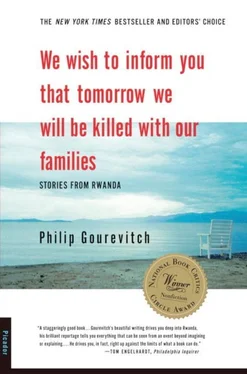Of course, the fact that guilty people remained free didn’t mean that those in prison were the right people. I asked Kagame if it bothered him that a good many innocent people might be in jail and that the experience might harden them into oppositionists. “Yeah,” he said. “It’s a problem. But that was the way to deal with the situation. If we had lost these people through revenge, that would have been an even bigger problem for us. I would rather address the problem of putting them in prison, because that is the best way to do it for the process of justice, and simply because I don’t want them out there, because people would actually kill them.”
IN JULY OF 1995, Rwanda’s National Commission of Triage—a sporadically functioning body charged with identifying prisoners against whom the accusations of genocide were insubstantial—ordered the release of Placide Koloni from the prison at Gitarama. Koloni had held the office of deputy governor before, during, and—until his arrest—after the genocide. This was normal; the majority of provincial and communal officials who had not fled Rwanda, or been jailed as génocidaires, had retained their posts. Koloni had spent five months as a prisoner, and upon his release he returned to his office. Three days later, on the night of July 27, a sentry at a UN military observers’ post staffed by Malian blue-helmets saw some men enter Koloni’s home. A scream was heard, and the house exploded in flames. The blue-helmets watched as the fire burned through the night. Shortly after dawn, they entered the house and found that Koloni, his wife, their two daughters, and a domestic had been killed.
A week later, a Hutu deputy governor in Gikongoro, to the west of Gitarama, and a Catholic priest in Kamonyi parish, not far from Kigali, were shot dead. An edgy mood settled over Rwanda, not because the death toll was especially high, but because the victims were prominent civic leaders. In mid-August, the government was shaken when the Prime Minister, Faustin Twagiramungu, and the Minister of the Interior, Seth Sendashonga, quit in protest over the persistent insecurity in the provinces, for which they blamed the RPA. Both men were Hutus—Twagiramungu, a leader of the anti-Hutu Power opposition under Habyarimana ; Sendashonga, a prominent member of the RPF—and both went into exile.
General Kagame, who never tired of reciting the number of RPA soldiers—four hundred, seven hundred; I lost count after a thousand—who had been thrown in military jails for killings and indiscipline, liked to point out that soldiers were not the only Rwandans frustrated to the point of criminality in the aftermath of the genocide and that Rwanda even has apolitical criminals. “But given the situation you have here,” he said, “ordinary crimes are not going to be looked at as ordinary crimes.” His distinction offered little comfort to frightened Hutus. “When we see how Koloni was killed, we’d rather be in here than out there,” a detainee told me at Gitarama prison, which was known as Rwanda’s worst prison in the summer of 1995.
At Gitarama, more than six thousand men were packed into a space built for seven hundred and fifty. That worked out to four prisoners per square yard: night and day, the prisoners had to stand or to sit between the legs of those who stood, and even in the dry season a scum of condensation, urine, and bits of dropped food covered the floor. The cramped prisoners’ feet and ankles, and sometimes their entire legs, swelled to two or three times normal size. They suffered from an atrophying of their swollen extremities and from rot; infection often followed. Hundreds had required amputations.
When Lieutenant Colonel R. V. Blanchette, a UN military observer from Canada, first learned of the conditions at Gitarama prison, he paid a visit. “I went down in the back with my flashlight,” he told me, “and I saw this guy’s foot. I’d heard it was pretty bad in there, but this was quite ugly—very swollen, and his little toe was missing. I shined my flashlight up to his face, and he reached down and pulled off the next toe.”
A few weeks after Blanchette’s encounter, prisoners at Gitarama told me that conditions were much improved. The Red Cross, which supplied the food and cooking fuel for all of Rwanda’s central prisons, had installed duckboards underfoot and evacuated the worst medical cases. “We had eighty-six deaths in June, and in July only eighteen,” a doctor at the prison clinic told me. The main causes of death, he added, were malaria and AIDS, which was normal for men in Rwanda, and while prison conditions remained grim—atrocious in most of the small community lockups—by mid-1996 mortality rates in the central prisons were reported to be lower than among the Rwandan population at large.
On the day of my visit to Gitarama prison, six thousand four hundred and twenty-four prisoners formed a solid-looking knot, and I had to plan each step I took with care. It was difficult to figure out how the people fitted together—which limbs went with which body, or why a head appeared to have grown three legs without a torso in between. Many of the feet were badly swollen. The bodies were clad in rags.
Yet the faces didn’t correspond to the discomfort in which the bodies were confined. They had a clarity and composure and forthrightness of expression that made the people inside the prison nearly indistinguishable from those outside. Here and there, of course, I would catch the electric glint of insane eyes or a ragged leer of unnerving brutality. But, pressing through the throng, I received the usual welcoming smiles, cheers, and handshakes. In the children’s cell, sixty-three boys, ranging in age from seven to sixteen, sat in rows on the floor, facing a blackboard where an older prisoner—a schoolteacher by profession—was conducting a lesson. They looked like schoolboys anywhere. I asked one why he was in prison. “They say I killed,” he said. “I didn’t.” Other children gave the same reply, with downcast eyes, evasive, as unconvincing as schoolboys anywhere.
Rwanda’s formal arrest procedures were rarely followed, and it was sometimes enough for someone to point a finger and say, “Genocide.” But, according to Luc Cote, a lawyer from Montreal who directed the UN Human Rights office in Butare, “most of the arrests were founded on some type of evidence, and a lot of the time there was a whole lot of evidence,” which meant that while they might be technically incorrect they weren’t necessarily arbitrary. And even if the procedures were followed to the letter, it wasn’t clear what difference it would make, since Rwanda’s courts were closed, and for more than two and a half years nobody was brought to trial.
The government attributed the judicial paralysis to its lack of financial and human resources. Police inspectors, responsible for assembling the dossiers against the accused, were constantly being recruited and trained, but even then most were amateurs who found themselves with hundreds of complex cases, no transportation, no support staff, and quite often threats coming at them from both accusers and accused. Rwanda pleaded for bicycles, motorcycles, and pencils and pens from foreign donors, but these basic necessities were much slower in coming than expressions of “concern” that not enough was being done to protect the rights of the accused.
NOBODY EVER TALKED seriously about conducting tens of thousands of murder trials in Rwanda. Western legal experts liked to say that even the lawyer-crowded United States could not have handled Rwanda’s caseload fairly and expeditiously. “It’s materially impossible to judge all those who participated in the massacres, and politically it’s no good, even though it’s just,” the RPF’s Tito Ruteremara told me. “This was a true genocide, and the only correct response is true justice. But Rwanda has the death penalty, and—well, that would mean a lot more killing.”
Читать дальше











